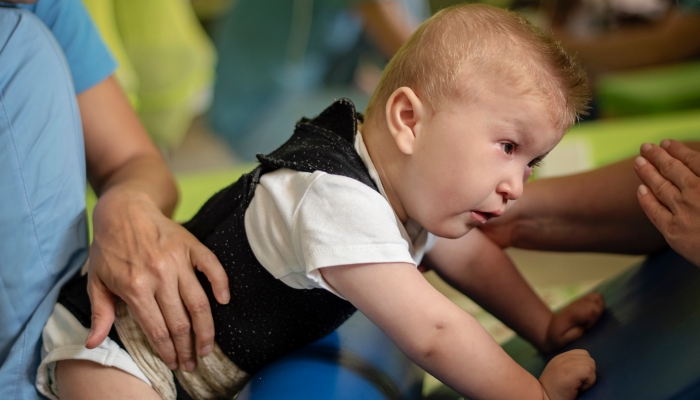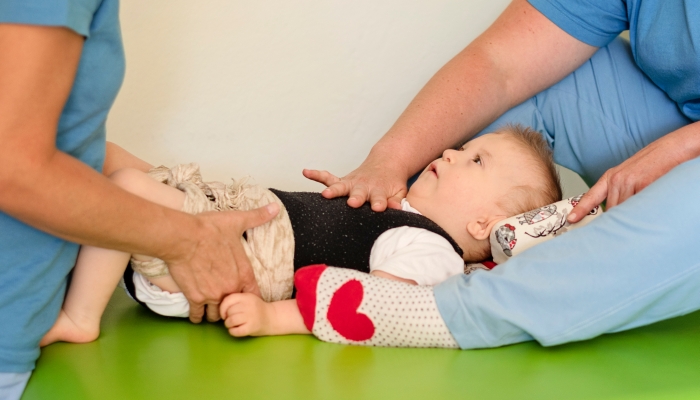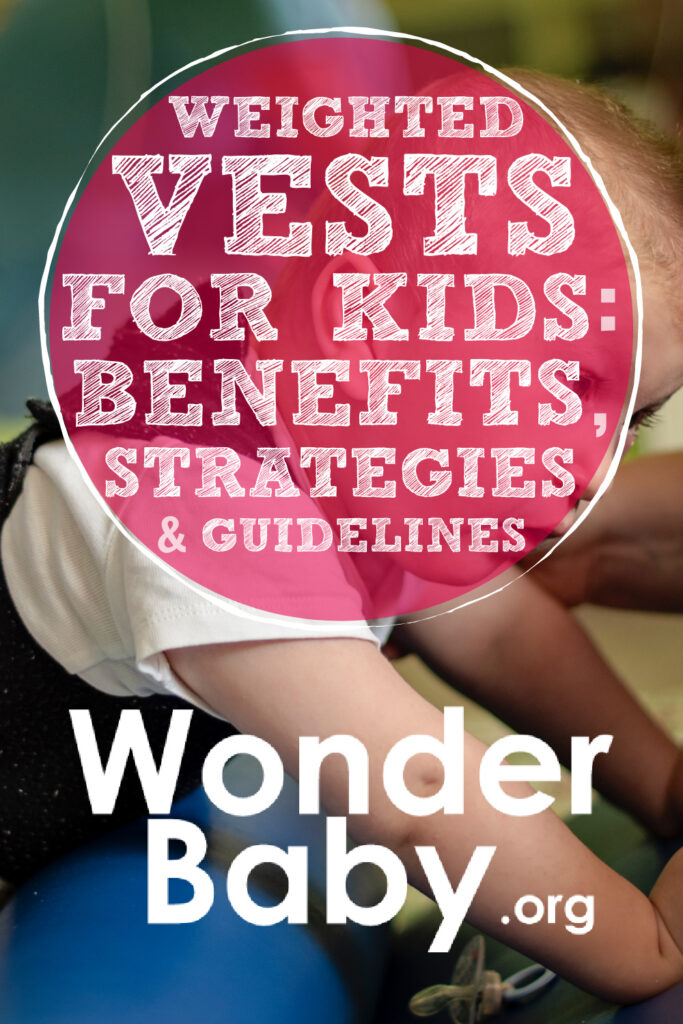Weighted Vests for Kids: Benefits, Strategies & Guidelines

This post may contain affiliate links; please see our terms of use for details.
- Weighted vests are vests with small weights sewn into pockets that are worn over normal clothes.
- Weighed vests apply deep touch pressure sensory input, which is beneficial for children with autism and sensory processing disorders.
- There are many benefits to wearing a weighted vest, including reduced anxiety, better self-regulation, improved focus and organizational skills, and better sleep habits.
- Weighted vests should weigh no more than 5-10% of your child’s body weight, and should be used under a set of guidelines, preferably after consulting with an occupational therapist.
At the end of a long day, I can struggle to wind down and fully relax. It feels like I wait all day for the chance to crawl into bed, and once I’m there, I can’t turn my mind off and fall asleep. It was suggested that I try using a weighted blanket, and its pressure truly helps me relax.
If you’ve ever experienced the calming effects of a weighted blanket, imagine being able to transfer those effects to your child throughout the day. This is where weighted vests come in. Weighted vests for kids have so many benefits, especially for children with autism and sensory processing disorder.
What Are Weighted Vests?
- HELPS KIDS RELAX AND FOCUS – This weighted compression vest helps kids remain calm. The deep touch pressure and proprioceptive input help your child relax and find focus.
- UNLOCK YOUR CHILD’S FULL POTENTIAL: Our Weighted Vest helps kids during school, therapy sessions, or playtime. You can add it to your child’s school sensory integration products and bring it on car rides to improve travel for your little sensory seeker.
- SIZE AND WEIGHTS – Comfortable to wear and easily put on with fully adjustable velcro for a great fit. The weighted vest has pockets for added weights (2 lbs of weights included). It comes in 3 sizes; check our sizing guide before buying!
- BREATHABLE, SNUG FIT DESIGN -Made with top-quality neoprene to endure daily use while offering consistent help for kids. This kid’s weighted vest is designed for a snug fit, crafted with soft, breathable fabric to ensure your child stays grounded. Breathable mesh on the front, back, and side is added to ensure comfort throughout the day.
Weighted vests are vests with small weights sewn into internal pockets. A weighted vest is worn over your child’s regular clothes (although a tight fitting undershirt can sometimes help with the vest fit).
The weights throughout the vest apply deep touch pressure to muscles and joints, which provides proprioceptive input. Proprioceptive input helps muscles and joints to become more responsive.
Weighted vests are different than compression vests because they sit on top of clothing and provide gentle but firm pressure. On the other hand, compression vests squeeze the torsos of the people wearing them, much like a tight hug. Compression vests are also much tighter fitting.
It is possible to use a weighted compression vest, which is a combination of the two vests. These types of vests are especially beneficial for sensory seekers. For sensory avoiders, a weighted vest without added compression would be best.
Weighted vests are adjustable to your child’s needs because you can add or remove weights as needed. They also come in different materials. Depending on your child’s preferences, you can choose a weighted vest in polyester, mesh, neoprene, denim, stretch denim, fleece, or even fur.
What is the Purpose of Weighted Vests?
Weighted vests are used to provide deep-pressure sensory input to children with sensory processing disorders or difficulties, including autistic children. Because of this, weighted vests are tools frequently used in sensory integration therapy.
Sensory integration therapy helps people process sensory information in order to improve their focus, attention, body movements, and participation in everyday activities.
The deep touch pressure (DTP) of a weighted vest is also believed to result in a calming effect that can also improve concentration and attention.
In a 2005 article by Tiffany Field, et al, we learn that deep touch pressure decreases the stress hormone, cortisol, which helps to calm the central nervous system in times of stress or anxiety.
Deep pressure has been shown to increase endorphin levels as well as the hormones responsible for happiness: serotonin and dopamine. This in turn improves the production of melatonin, which is responsible for sleep.
By decreasing cortisol levels and increasing dopamine and serotonin levels, the deep touch pressure balances out the body’s nervous system and helps regulate emotions and responses to sensory information.
Besides being beneficial to kids with sensory processing disorder or autism spectrum disorder, weighted vests are also beneficial to kids with ADHD.
Hung-Yu Lin, Posen Lee, Wen-Dien Chang, and Fu-Yuan Hong discuss in their co-authored 2014 article titled Effects of Weighted Vests on Attention, Impulse Control, and On-Task Behavior in Children With Attention Deficit Hyperactivity Disorder how “the deep touch pressure input provided by weighted vests…improves three aspects of attentional performance, including inattention…, speed of processing and responding…, and consistency of executive management…, and three types of on-task behaviors, including off task, out of seat, and fidgets.”
All in all, weighted vests are used with children for a variety of reasons, including improving self-regulation, better sensory processing, calming the central nervous system, enhancing focus and attention, and decreasing anxiety.

15 Benefits of Weighted Vests for Kids
All children and their needs are unique. Not all of the following benefits of weighted vests may be observed in your child, but they are definite possibilities!
- Reduced anxiety: Deep pressure reduces the stress hormone cortisol, which also reduces anxiety.
- Better self-regulation: When struggling with sensory input or sensory overload, children enter into “fight or flight” mode. The deep pressure of weighted vests calms the nervous system and organizes the brain, which results in better emotional regulation.
- Improved body awareness: The weights apply pressure to muscles and joints which results in improved body awareness/proprioceptive input.
- Improved sensory processing: Deep touch pressure gives input sensory seekers crave and helps calm sensory avoiders.
- Increased focus, attention, and time-on-task: According to Hung-Yu Lin, et al, children with ADHD respond to weighted vests by sitting still for longer amounts of time, focusing better, and completing tasks.
- Decreased self-stimulatory behaviors: In a 2001 study by Fertel-Daly, Bedell, and Hinojosa, 4 out 5 children on the autism spectrum showed a decrease in self-stimulatory behaviors while wearing weighted vests.
- Decreased hyperactivity: Weighted vests calm the nervous system, which results in less hyperactivity.
- Improved organizational skills: Studies show that children’s executive functioning, or organizational skills, improve while wearing weighted vests.
- Better sleeping habits: The weights provide deep touch pressure which increases melatonin production. Melatonin is the sleep hormone that promotes better sleep and relaxation.
- Increased interoception awareness: Children become more aware of when they are hungry, thirsty, hot or cold, etc.
How Heavy Should Your Kid’s Weighted Vest Be?
There is no one-size-fits-all when it comes to weighted vests and how heavy they should be. A general rule is that the weighted vest should typically weigh 5-10% of your child’s body weight. (Weighted blankets, on the other hand, are usually 10-15% of your child’s body weight.)
This means if your child weighs 40 pounds, the vest should weigh between 2 and 4 pounds. You shouldn’t necessarily jump straight to 5% or 10% of your child’s body weight right away. Every child has preferences and tolerances when it comes to sensory input.
One of the good things about weighted vests is that they’re adjustable, so you can start light and slowly increase the weight as your child tolerates it. When adding weights, they should be distributed throughout the vest as evenly as possible.
Strategies & Guidelines When Using Weighted Vests for Kids
To maximize the potential benefits of weighted vests, it’s important to follow some guidelines:
- If your child has an occupational therapist (OT), consult with them before using a weighted vest. They can help you carefully adjust the weights, find what works best for your child, and help you figure out if the weighted vest is working.
- Introduce the weighted vest during an enjoyable activity for your child that doesn’t last any longer than 20 minutes.
- Weighted vests are not recommended for children under 3 years old.
- Start with a lightweight vest and increase weights as necessary or tolerated.
- The weight of the vest should never be higher than 15% of your child’s body weight.
- Weights should be evenly distributed throughout the vest and around your child’s midsection.
- The vest should fit snuggly over your child’s body, but it should still be able to fit over their normal clothes.
- Find a vest in the material your child prefers – there are many different materials to choose from!
- Before exploring weighted vests, consider which behaviors you would like to improve. This will help you figure out the best times to wear the vest. For example, if your child struggles with loud or stressful environments (i.e. loud classrooms or doctor’s appointments), you may want to use the vest during those times. If your child struggles with sitting still to complete a task or focus, you may want to use the vest during those activities instead.
- Set up a schedule for wearing the vest 2-3 times per day. The effects of the vest are often continued after the vest is removed.
- Collect data on how well the vest is working during different activities or times of day – you may need to do a little trial and error.
- If the effects of a weighted vest decrease after some time (six months or so), you may need to remove it from your daily strategies for a short time and then bring it back into the rotation, much like rotating toys.
- Vests should only be worn for 15-20 minutes at a time. If worn any longer, the body becomes used to the feeling, and the vest can become ineffective. Before putting the vest back on, wait at least an hour.
- Vests are most effective when used preventatively rather than on a child who is already experiencing sensory overload. This is why setting a wearing schedule or choosing a vest for certain activities is most important.
- Discontinue the use of a vest if your child seems more agitated, breathes abnormally, sweats a lot, or they continually try to take it off.
- If a weighted vest seems like too much sensory input for your child, consider trying weighted lap pads instead.
- Huggable Comfort – Ground on the go with your weighted stuffed animals. Give kids a reassuring squeeze they can take in your 2 included travel bags with their 5 lb. weighted plush pal.
- Find Focus – Meant for anyone with ASD, sensory processing, or attention disorders, your weighted lap pad for adults and kids helps you focus on the present whether you’re overwhelmed or need fidgets.
- Rough & Tumble Ready – Stretch and spill on your soft weighted blanket for kids without ripping and ruining it. Your dog relief toy has strong stitching and a machine-washable outer layer.
- Sensory Satisfaction – Endlessly enjoy your weighted lap animal. Suit your kid’s stimming needs with your fidget blanket’s soft fur, fidgety feet, and 12 sections of quiet, scentless, weighted beads.

Related Posts

Eye Conditions and Syndromes, Visual Impairment
Neuralink Announces Plans to Restore Sight to the Blind with Brain Chip
Elon Musk’s company Neuralink has announced plans to begin human trials of its new “Blindsight” brain chip by the end of 2025.

Special Needs
5 Spring Cleaning Tips for Families of Children with Disabilities
Spring cleaning is an opportunity to create a more accessible, organized, and supportive space for your child with disabilities. Declutter, deep clean, and refresh!

Visual Impairment
The Gift of Understanding: How a Young Child Helps His Blind Father Navigate Life
When a parent is blind, it’s natural for people to wonder how their sighted child will adapt. Will they struggle to understand their parent’s needs? Will they feel burdened by...

